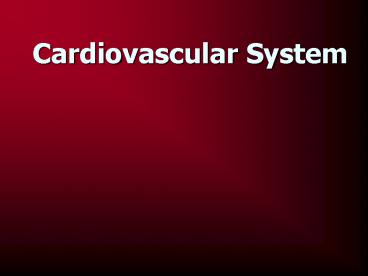Cardiovascular System - PowerPoint PPT Presentation
1 / 15
Title:
Cardiovascular System
Description:
Cardiovascular System Role of the Cardiovascular System the body s delivery service the heart pumps blood through the blood vessels to the entire body. – PowerPoint PPT presentation
Number of Views:335
Avg rating:3.0/5.0
Title: Cardiovascular System
1
Cardiovascular System
2
Role of the Cardiovascular System
- the bodys delivery service
- the heart pumps blood through the blood vessels
to the entire body.
3
The Heart
- The heart is a muscular organ, about the size of
your fist, located between the lungs behind the
sternum. - It is a pump that beats an average of 72 times a
minute, 100,000 times a day, and 3 trillion times
an averabe lifetime. - beating heart
4
The Pericardium
- The pericardium is a protective sac covering the
heart - made up of two layers
- Visceral pericardium inner layer next to heart
- Parietal pericardium outer layer
5
Chambers of the Heart
- the heart is divided into right and left sides by
a wall called the septum - the heart has four chambers two upper,
thin-walled atria, and two lower, thick-walled
ventricles.
6
Valves of the Heart
- Some valves control the flow of blood within the
heart - Mitral (bicuspid) valve between the left atrium
and left ventricle - Tricuspid valve between the right atrium and
right ventricle - The pulmonary and aortic valves stop the backflow
of blood into the heart
7
Blood Flow
- The cardiovascular system has three types of
blood vessels - Arteries (and arterioles) carry blood away from
the heart - Capillaries where nutrient and gas exchange
occur - Veins (and venules) carry blood toward the
heart.
8
Passage of Blood Through Heart
- Each atria pumps blood to a ventricle through
valves. (tricuspid and mitral valve) - The right ventricle will pump blood to the lungs
to be oxygenated (via pulmonary artery) and the
blood will return to the heart via the pulmonary
vein. - The oxygenated blood returns to the left atrium,
then to the left ventricle and out through the
aorta to the body.
9
Cardiac Conduction System
- contained in special heart tissue called
conductive tissue - controls electrical impulses that cause the heart
to contract
10
Circulation
- circulation is the flow of blood
- There are three types
- Coronary circulation
- Pulmonary circulation
- Systemic circulation
11
Coronary Circulation
- the circulation of blood within the heart
- the coronary arteries (branch off the aorta)
supply blood to the heart muscle - Since the coronary arteries are so small, they
are easily clogged, leading to heart disease.
12
Pulmonary Circulation
- the flow of blood between the heart and lungs
- pulmonary arteries carry blood low in oxygen from
the right ventricle to the lungs to get oxygen - pulmonary veins return oxygen-rich blood to the
left atrium.
13
Systemic Circulation
- the flow of blood between the heart and the cells
of the body - The aorta branches with an artery going to each
specific organ. - eg. the carotid artery supplies blood to the head
and neck - Generally, an artery divides
- into arterioles and capillaries
- which then lead to venules
- and veins
14
Pulmonary and Systemic Circulation
15
Major arteries and veins of systemic circulation

